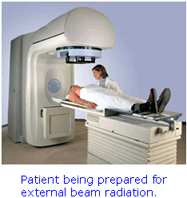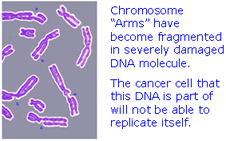 Radiation is versatile. It can be used to treat virtually any type of cancer and there are multiple delivery systems; and it also works well in combination with both surgery and chemo.
Radiation is versatile. It can be used to treat virtually any type of cancer and there are multiple delivery systems; and it also works well in combination with both surgery and chemo.
Why so effective?
Because once atoms are crippled by radiation the damage to chromosomes is severe and DNA replication becomes impossible (which means cancer cells cannot divide and replicate); all this is accomplished with much less collateral damage than chemo's attack at the cellular level.
Targets
Radiation is used to treat (and shrink) almost every type of solid tumor -- including those found in the brain, breast, lung, uterus and prostate; it also can be used to treat cancers of the blood and lymphatic system.
Delivery
External radiation therapy (given on an outpatient basis) is far more prevalent than the alternative of delivering radiation on an internal basis (although implanted radiation "seeds" have become a commonplace way of treating prostate tumors).
 Patient Hardships
Patient Hardships
Often radiation requires multiple treatments. In the case of breast cancer, for example radiation sessions often are required 5 days a week for up to 6 consecutive weeks. Getting to a doctor's office this often - especially if the patient works or takes care of a family -- can be very burdensome. In addition to the logistics of transportation, radiation side effects can include rashes and fatigue.